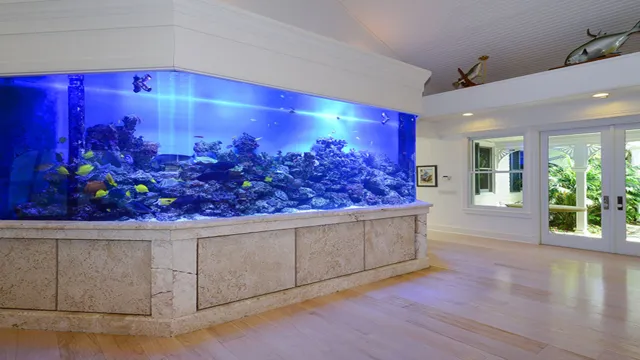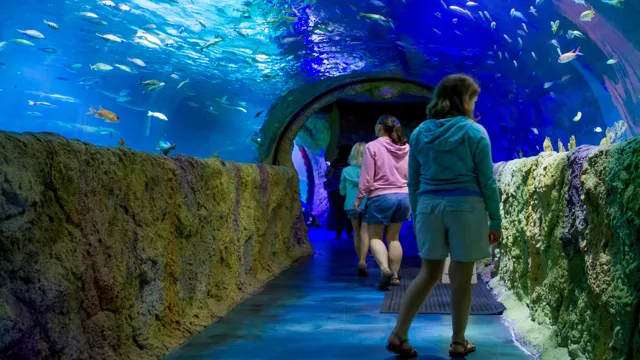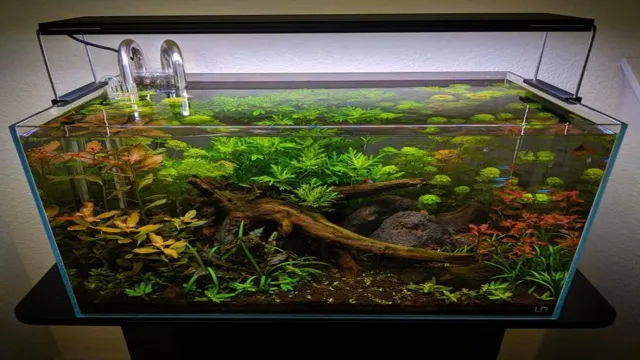Are you looking for a unique and rewarding project to take on? If you’re an aquarium enthusiast, building a large saltwater aquarium could be precisely what you need to challenge yourself! Not only is this endeavor an excellent opportunity to showcase your creativity, but it’s also a chance to create an aquatic ecosystem that’s both stunning and healthy for the fish that will ultimately call it home. Assembling a large saltwater aquarium is no simple feat, but with the right approach and mindset, it’s a labor of love that can be truly magical. The process involves carefully selecting a tank that suits your needs, choosing the right filtration and lighting systems, adding sand, rocks, and coral, and ultimately introducing the right mix of saltwater fish.
With patience, time, and attention to detail, building a large saltwater aquarium can pay off in a big way. Not only will you be able to enjoy the beautiful, colorful fish and corals, but you’ll also get to witness the intricate ecosystem you’ve created thrive and grow. So, are you ready to dive into this exciting project? Let’s explore some tips and tricks that can help you build the aquarium of your dreams!
Planning and Preparation
Building a large saltwater aquarium can be a rewarding but challenging experience. The first step in this process is proper planning and preparation. This involves researching the types of fish and corals you want to keep, as well as the equipment needed to maintain a thriving ecosystem within your tank.
It’s important to consider the size of your tank, as well as the filtration system and lighting required to keep everything in balance. Choosing the right location for your aquarium is also crucial, as it should be situated in a place that is easily accessible for maintenance and cleaning, and away from direct sunlight or extreme temperatures. Additionally, preparing your water chemistry and cycling your tank before adding any livestock is necessary for creating a healthy environment for your aquatic animals.
Planning and preparation may take time, but it’s essential for the success of your saltwater aquarium.
Assessing Space and Budget
Assessing Space and Budget for your project is an essential part of Planning and Preparation. Knowing how much space you have available, and what budget you can allocate towards your project, will help you determine what materials and tools you’ll need to purchase. It’s important to measure the space accurately, as you don’t want to purchase materials that are too large or too small for the project.
When considering your budget, it’s also important to think about any other expenses you may have, such as labor costs or permits. Remember, the space and budget you have will ultimately determine the scope of your project, so take the time to assess them thoroughly. By doing so, you’ll be able to plan and execute your project effectively, and avoid any unexpected surprises along the way.

Choosing the Right Equipment
When it comes to choosing the right equipment for your project, planning and preparation are essential. Before making any purchases, take the time to assess your needs and research the available options. Consider the specific requirements of your project, such as budget, size, weight, and durability, as well as any regulatory or safety requirements that may apply.
Once you have a clear idea of what you need, start looking for equipment that meets those criteria. Don’t forget to factor in additional costs, such as maintenance, repairs, and replacement parts, when making your decision. Remember, choosing the right equipment is key to the success of your project, so take your time and do your research.
Selecting the Right Fish and Coral
When it comes to selecting the right fish and coral for your aquarium, careful planning and preparation are key! Once you have your tank set up and ready to go, take some time to research which species will thrive in your specific environment. Consider factors such as water temperature, pH levels, and the size of your tank. It’s also important to think about the compatibility of different species.
Some fish and coral may not get along with others, so it’s best to choose ones that will coexist peacefully. Don’t forget to consider the level of care each species requires and whether or not you have the time and resources to provide it. With careful planning and preparation, you can create a beautiful and thriving underwater world in your own home.
Installing and Setting Up the Aquarium
Ready to bring a piece of the ocean into your home with a large saltwater aquarium? Building and setting up a saltwater aquarium can be an exciting and fulfilling experience. Before diving in, consider the size and location of your aquarium—ensure that it is big enough for your selected fish species to thrive and placed in a stable location with enough natural light. Once you have chosen your aquarium, the next step is to install the necessary equipment such as the filter, protein skimmer, heater, and lighting system.
Ensure that the equipment is appropriately sized for your aquarium’s volume to maintain a healthy environment. Fill the tank with a high-quality saltwater mix, give it a couple of days to stabilize, and then add live rock to start forming natural filtration. Finally, test the water regularly and make adjustments as needed to ensure the water parameters stay within healthy levels.
By following these steps and giving your aquarium proper care, you’ll be able to build a thriving marine ecosystem right in your own home.
Assembling and Positioning the Tank
Assembling and positioning the tank is a crucial step in setting up your aquarium. First, clean the tank with warm water and a mild soap solution to remove any dirt or residue. Rinse the tank thoroughly to remove any soap residue.
Then, place a layer of substrate at the bottom of the tank to create a healthy environment for your fish. After the substrate, add a layer of filter media to promote a healthy ecosystem within the tank. When positioning the tank, make sure to choose a stable and level surface, away from direct sunlight and any drafty areas.
Avoid putting the tank near any electrical outlets or appliances that can cause water damage. Once you have the tank in the desired position, fill it with water and let it stand for at least 24 hours to ensure that the tank is watertight and won’t leak. After the 24-hour period, add a conditioner to neutralize any chemicals in the water that can be harmful to your fish. (See Also: How to Get Rid of Ammonia in Saltwater Aquarium: 6 Effective Tips)
Now that your aquarium is set up, it’s time to introduce your fish to their new home!
Adding Substrate and Decorations
When it comes to setting up your aquarium, adding the substrate and decorations is a crucial aspect of creating the perfect underwater environment for your aquatic pets. First and foremost, choose the right type of substrate depending on the needs of your fish and plants. Gravel, sand, and soil are some common options, each with their own advantages and disadvantages.
Once you’ve selected the right substrate, it’s time to add decorations like rocks, driftwood, and plants, which can help create a natural-looking habitat and provide hiding places for your fish. When placing decorations, make sure to leave enough space for your fish to swim around freely while also creating visually engaging areas for them to explore. Remember, the substrate and decorations are not only for aesthetic purposes, but also play a crucial role in the health and happiness of your aquatic pets.
Installing Filter and Lighting Systems
Setting up an aquarium can be a fun and rewarding experience, but it does require some planning and effort. One important aspect of setting up an aquarium is installing a filter and lighting system. A filter is crucial, as it helps to remove waste and debris from the water, which can harm your fish and plants.
There are many different types of filters available, including hang-on-back, canister, and sponge filters. When choosing a filter, consider the size of your aquarium and the type of fish and plants you plan to keep. Lighting is also important, as it helps to replicate the natural environment of your fish and plants.
Depending on the type of aquarium you have, you may need to invest in specific lighting, such as LED or fluorescent. Proper lighting not only helps your fish and plants to thrive but also allows you to enjoy the beauty and colors of your aquarium. By taking the time to properly install and set up your filter and lighting systems, you can create a healthy and beautiful aquatic environment for your fish to thrive in.
Filling and Cycling the Tank
When it comes to setting up a new aquarium, one of the first steps is filling and cycling the tank. Before adding any fish or plants, it’s important to add water to the tank and treat it with a dechlorinator to remove any harmful chemicals. Once the water is in the tank, it’s time to cycle the tank.
This involves growing beneficial bacteria in the filter to help break down any harmful toxins that may accumulate in the tank. Cycling the tank can take anywhere from a few weeks to a few months, depending on the size of the tank and the type of filter being used. It’s important to test the water regularly during this process to make sure the levels of ammonia, nitrite, and nitrate are safe for fish.
Once the tank has been cycled and the water is safe, it’s time to start adding fish and plants to create a beautiful underwater world. Remember to start slow and not add too many fish at once to avoid overloading the filter and causing any stress to the fish. With a little patience and care, your new aquarium will be thriving in no time.
Maintaining the Aquarium
Building a large saltwater aquarium is one thing, but maintaining it is an entirely different ball game. You need to keep the water quality in check constantly, test it regularly, and ensure that all the equipment is working efficiently. One of the essential things to maintain in a saltwater aquarium is the water temperature.
A temperature that’s too high or low can affect the fish and coral. Additionally, you must replace the water regularly since the salt levels can increase over time. Doing this will also help manage the levels of nutrients in the water, which can lead to algae growth if they get too high.
Moreover, cleaning the aquarium is crucial to maintaining its cleanliness. You can do this by using a siphon to vacuum any debris off the substrate, and by wiping down the glass regularly. By keeping these factors in mind, you can ensure that your large saltwater aquarium thrives in the long run.
Establishing a Maintenance Routine
Maintaining an aquarium is not just about ensuring your fish have a clean and comfortable space to live, but it is also about keeping their environment healthy and safe. To establish a maintenance routine for your aquarium, you need to break down the tasks into daily, weekly, and monthly chores. Your daily tasks should include checking the temperature and pH levels, feeding your fish, and removing any uneaten food.
Weekly tasks should consist of cleaning the tank walls, replacing a percentage of the water, and testing the water quality. Lastly, monthly tasks should involve deep cleaning filters, gravel and decorations, and pruning plants if necessary. By staying on top of these tasks, you can create a thriving environment for your aquatic pets and increase their lifespan.
Keep in mind that each aquarium is different, and you may need to adjust your routine based on the size and type of aquarium. Remember, consistency is key when it comes to maintaining a healthy and beautiful aquarium.
Monitoring Water Parameters
Maintaining an aquarium can be fun and rewarding, but it’s important to ensure the water parameters are in balance to keep your fish and other aquatic creatures healthy. Monitoring pH levels, temperature, ammonia, nitrate, and nitrite levels is essential. Changes in water temperature or pH levels can cause stress or even death to your fish. (See Also: How to Get White Scale off Aquarium – Quick and Easy Techniques)
Testing the water parameters frequently will help you catch any problems early and keep your aquarium in top condition. One great way to monitor the water parameters is by using a testing kit. These kits are easy to use and come with clear instructions on how to check and interpret the results.
It’s important to follow the instructions carefully and to check the parameters regularly to keep your aquarium in a healthy state. So remember, monitoring your water parameters is key to maintaining a thriving aquarium!
Maintaining the Equipment
Maintaining an aquarium can be great fun, but it also comes with a lot of responsibility. One of the most critical aspects of aquarium maintenance is keeping the equipment in good working order. Filters, heaters, and pumps all play a crucial role in maintaining the aquarium’s ecosystem and should be regularly checked, cleaned, and replaced if necessary.
Dust, debris, and algae can all clog the filters and pumps, leading to reduced water flow and contaminating the water. The heaters must be calibrated correctly to maintain the water temperature, and regular water changes are essential to maintain good water quality. It’s also important to periodically test the water’s pH levels, nitrate and nitrite levels, and ammonia levels, to ensure that the aquarium’s inhabitants remain healthy and happy.
Lastly, keeping a log of the maintenance schedule can help you stay on top of all these tasks and ensure that everything is done according to a plan.
Maintaining the Fish and Coral
Maintaining an aquarium can be a fascinating hobby, but it is a responsibility that needs to be taken seriously to keep the fish and coral healthy. Aquarium maintenance requires regular care to keep the water and the environment optimal for the fish and coral to survive. One crucial part of aquarium maintenance is to check the water quality regularly.
The pH level, nitrate, and ammonia levels should be just right, as any fluctuation can be fatal to fish and coral. Keeping the glass clean and free from algae or bacteria buildup is another aspect of maintenance that must be done carefully. Finally, regular feeding of the fish and checking the equipment regularly for any malfunction or damage is vital for the maintenance of an aquarium.
Overall, maintaining an aquarium takes dedication and care, but it is a fulfilling experience to see the fish and coral thrive in a healthy and well-maintained environment.
Troubleshooting and Problem-Solving
If you’re looking to build a large saltwater aquarium, there are a few things to keep in mind. First, it’s important to consider the size and weight of the tank as well as the materials you’ll need to properly set it up. Next, you’ll want to make sure you have a good filtration system that can handle the size of your tank and keep the water clean.
It’s also important to choose the right lighting and temperature control systems to create a healthy environment for your fish and other marine life. When troubleshooting any issues that arise, make sure to test the water regularly and address any imbalances or chemical changes. Overall, building a large saltwater aquarium can be a challenging but rewarding experience for any aquarium enthusiast.
Just remember to take your time, do your research, and seek the advice of professionals or experienced hobbyists as needed.
Identifying Common Aquarium Issues
Identifying Common Aquarium Issues Whether you’re a beginner or a seasoned aquarium owner, you’ll likely face a range of issues that can put your fish and plants in jeopardy. One common problem is algae growth. Algae can quickly take over your tank, cloud the water and harm your aquatic pets.
To control algae, limit the amount of light and nutrients in the water, and consider adding algae-eating fish to your tank. Another issue is water quality. Poor water quality can cause an array of problems, such as ammonia buildup, nitrate toxicity, and pH imbalances.
Regular water changes can help maintain stable water conditions, as can proper filtration and adequate oxygenation. Other common aquarium issues include heater malfunctions, disease outbreaks, and overfeeding. By troubleshooting and problem-solving, you can keep your aquarium thriving and your fish happy and healthy.
Dealing with Algae and Other Pests
Dealing with algae and other pests in your aquarium can be a frustrating experience for any fish keeper. Algae thrive in environments with excess nutrients and too much light, so keeping your tank clean and properly lit is crucial in preventing outbreaks. However, if you do find yourself facing a pesky algae bloom, there are several ways to combat it. (See Also: How to Make Soil Substrate for Aquarium: A Step-by-Step Guide)
One effective method is to manually remove the algae with a scraper or brush and perform regular water changes to reduce nutrient levels. Another option is to add algae-eating fish or invertebrates, such as Siamese algae eaters or Amano shrimp, to your tank. When it comes to other pests like snails or planaria, removing them by hand or using a pest-specific treatment can be effective.
However, it’s important to research any treatment options thoroughly and consider the potential impact on your aquarium’s inhabitants. Overall, taking preventative measures through proper maintenance and research can save you a lot of headaches in the long run!
Handling Emergencies and Accidents
When it comes to handling emergencies and accidents, troubleshooting and problem-solving are essential skills to have. Whether it’s a medical emergency, natural disaster, or car accident, being prepared to handle the situation can make all the difference. The first step is to assess the situation and prioritize the needs of those involved – determine if medical attention is necessary, and if anyone is in immediate danger.
Once the situation is under control, it’s important to gather information and communicate effectively with emergency personnel, insurance companies, and any other parties involved. Being calm and level-headed can help you think clearly and make quick decisions in a high-pressure situation. Remember, emergencies are unpredictable, but having a plan in place and being prepared to troubleshoot and problem-solve can make all the difference.
Conclusion
In conclusion, building a large saltwater aquarium requires patience, knowledge, and a deep appreciation for the aquatic world. It’s a journey that requires a delicate balance of scientific understanding, creativity, and artistic vision. Just like any great masterpiece, building a large saltwater aquarium takes time, effort, and plenty of trial and error.
But in the end, the reward of seeing a thriving underwater ecosystem come to life before your very eyes makes it all worthwhile. So, whether you’re a seasoned aquarium enthusiast or just starting out, remember to keep your water parameters in check, pay attention to your fish and coral’s needs, and of course, don’t forget to have fun along the way.”
FAQs
What size tank is needed for a large saltwater aquarium?
The minimum size for a large saltwater aquarium is typically around 75 gallons, but larger tanks such as 100-200 gallons or even bigger are recommended for the best results.
How do you cycle a saltwater aquarium?
Cycling a saltwater aquarium involves establishing beneficial bacteria in the tank to break down waste and toxins. This can be done using a nitrogen cycle method or by adding live rock or sand.
What types of fish and marine life are suitable for a large saltwater aquarium?
Some popular fish for large saltwater aquariums include tangs, angelfish, groupers, and wrasses. Other marine life like corals and invertebrates can also be added.
How often should water be changed in a large saltwater aquarium?
Water changes should be done regularly to maintain good water quality and remove excess nutrients. For a large saltwater aquarium, water changes of 10-20% should be done every 2-4 weeks.
What equipment is needed for a large saltwater aquarium setup?
Equipment needed includes a good quality protein skimmer, high-quality lighting, a powerful filtration system, a heater, and a thermometer.
How do you maintain stable water parameters in a large saltwater aquarium?
Stable water parameters are important for the health of the fish and marine life in the aquarium. Consistent monitoring of water temperature, salinity, pH, and other levels, as well as regular water changes, can help maintain optimal conditions.
Can a large saltwater aquarium be self-sustaining?
A self-sustaining saltwater aquarium is possible but requires a lot of planning, knowledge, and the right equipment. It may involve creating a natural ecosystem with live rock, sand, and other marine life to maintain water quality and balance.







